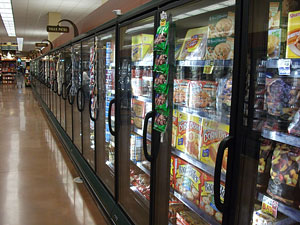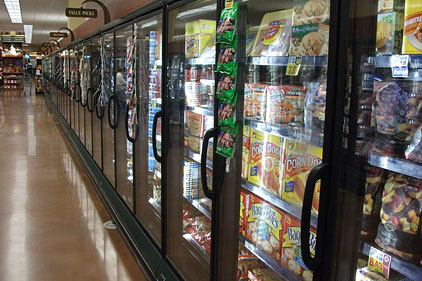
|
| After the display case door retrofits are completed, system checks should be conducted. |
After the completion of the case retrofits and reconfiguration of the refrigeration system as warranted, it is essential to test the performance of the refrigeration equipment in use.
Before long-term merchandising use of the system is initiated, the following system characteristics should be inspected and verified:
1. Leak testing: All refrigerant line runs affected or modified during the retrofit project and related work should be tested for leaks using a micron gauge and following standard refrigeration system inspection practices. U.S. Environmental Protection Agency (EPA) guidelines should be followed and used to direct this process.
2. Suction line superheat: Values should be measured at appropriate points in the suction line and compared to design specification values. Proper adjustments should be made to ensure alignment with desired values specified in the system design.
3. Discharge air temperature and return air temperature: Measurements of air temperature in each case at the discharge and return air grilles should be taken and compared to the desired design values. Depending on the desired performance effect, discharge and return air temperatures may be higher, possibly on the order of 4-5°F, after the retrofit, while maintaining the same internal product temperature. These values should be measured over a period of 24 hours in order to gain a complete picture of the system operation.
4. Defrost operation: Defrost settings configured for open display cases will likely have been adjusted in retrofitted cases due to the large reduction in infiltrated air and associated moisture. Care should be taken to ensure that reconfigured defrost systems are operating as intended.
5. Controls: Control settings and programming should be reviewed to ensure that field configuration aligns with design intent.
6. Compressor operation: Compressor cycling times and frequency should be measured in order to ensure that excessive compressor cycling is not occurring due to reduced system loads. In many instances, modern control systems incorporate the capability to record system operating characteristics such as compressor duty cycle and run time. In lieu of this, timers and counters can be installed on each compressor for data-gathering purposes.
7. Liquid line subcooling: Values should be measured at appropriate points in the liquid line and compared to design specification values.
8. Expansion valve settings: Expansion valves should be inspected to ensure that the settings are appropriate for the refrigerant flow rates and properties necessary to maintain proper temperature in the reconfigured cases.
9. Condenser operation: Measurements of the condenser temperature should be taken and compared to the design value. Correct operation of condenser controls should be verified based on standard maintenance protocols.
10. Refrigerant charge levels: System charge levels should be measured in accordance with standard maintenance procedures and compared against calculated required values for the reconfigured system.
11. Electrical loads: System electrical loads should be measured at peak operation to ensure that the electrical connections and safety devices such as circuit breakers remain properly sized for the reconfigured refrigeration system.
12. Anti-sweat heater operation: If anti-condensate heaters were installed with the display doors, their operation, along with that of any anti-sweat heater controls used, should be checked before long-term operation commences to ensure that they are set to the appropriate power level for the store’s range of ambient conditions.
13. Lubricant return: Refrigerant piping originally designed for open cases, which require a higher refrigerant throughput, may have been reconfigured to match the new case heat loads. Lubricant return rates and sump oil levels should be checked by visual inspection using installed sight glasses to ensure that the compressors are receiving the needed lubricant flow.
14. System alarms: Appropriate alarms should be programmed into the refrigeration-system controls to modify system performance in light of detected issues and to alert building staff of problems as they occur.
Additionally, design plans should be compared to as-built drawings and revised for future use if the field installation required changes not initially reflected in the design drawings.
After the system has been deemed to be operating satisfactorily, products previously removed from the affected cases during the retrofit can be loaded back into those cases, and the cases may be returned to merchandising duty.
Monitoring and Follow-Up
As a retailer’s prime motivation for retrofitting open display cases with doors is generally the desire to save energy, it is essential that the upgraded refrigeration system and display cases be monitored after the initial completion of the retrofit activities. Building engineering staff or the refrigeration service contractor should be retained to monitor performance and collect data. This is essential in ensuring that the system is performing at the optimum level across the possible variety of climatic conditions and shopper volumes to which it will be exposed.
The most fundamental way to gauge system performance from an energy standpoint is to monitor refrigeration system energy consumption. Metered electricity consumption data should be collected regularly, if possible on a per-refrigeration-system basis. Data should be compared against existing benchmark data, as well as against projected energy consumption as calculated during the initial workup to the retrofit project. Comparisons should, if at all possible, take into consideration factors including climate (comparing the same month across two years, correlating refrigeration energy data to ambient temperature, for example) and shopper traffic.
Additional monitoring should include regular evaluation of physical system characteristics such as the following:
• Discharge-air temperature and return-air temperature;
• Defrost operation;
• Suction line superheat;
• Liquid line subcooling;
• Condenser operating temperatures;
• Refrigerant charge levels;
• Anti-sweat heater operation; and
• Lubricant return.
Discrepancies in metered system electricity consumption or the presence of system operating characteristics, including those listed above, outside of the desired range would serve as grounds for re-evaluation of system configuration.
EDITOR’S NOTE: This work was accomplished with the guidance of Brian Holuj, Jason Koman, and Kristen Taddonio of the DOE, and through the contributions of many Better Building Alliance (BBA) members and representatives of industry. The DOE wishes to particularly acknowledge the efforts of the following parties: DC Engineering, Hillphoenix, Hussmann Corp., REMIS America LLC and REMIS GmbH, and Zero Zone Inc.
This report should be viewed as a general guide to best practices and factors for consideration by end users who are planning or evaluating a retrofit operation, rather than a comprehensive and exhaustive set of specific steps to perform when retrofitting display cases. A qualified refrigeration engineer or firm should always be contracted to oversee any retrofit project. This report was prepared as an account of work sponsored by an agency of the United States government. Neither the United States government, nor any agency thereof, nor any of their employees, nor any of their contractors, subcontractors, or their employees, makes any warranty, express or implied, or assumes any legal liability or responsibility for the accuracy, completeness, or usefulness of any information, apparatus, product, or process disclosed, or represents that its use would not infringe privately owned rights. Reference herein to any specific commercial product, process, or service by trade name, trademark, manufacturer, or otherwise, does not necessarily constitute or imply its endorsement, recommendation, or favoring by the United States government or any agency, contractor, or subcontractor thereof.
Publication date: 8/19/2013


Report Abusive Comment